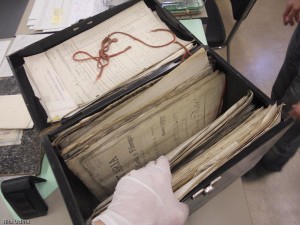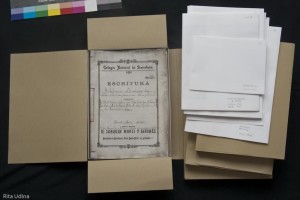Minimal intervention on “Serra & Balet” documents
 Documents proceeding from “Serra & Balet Manufactures” factory had been forgotten by men for years, but not by microorganisms, which saw in the darkness of the container and the nutrient of the content a good place to grow and expand their colony. This metal box was miraculously rescued from scrap by a man who warned its value despite its origin and pitiful appearance (do you want to know this heritage hero?).
Documents proceeding from “Serra & Balet Manufactures” factory had been forgotten by men for years, but not by microorganisms, which saw in the darkness of the container and the nutrient of the content a good place to grow and expand their colony. This metal box was miraculously rescued from scrap by a man who warned its value despite its origin and pitiful appearance (do you want to know this heritage hero?).
This documentation is a good example of the standard treatments, the famous “minimal intervention” that slightly damaged documents undergo to extend its life.
Treatment of minimal intervention:
- Mould treatment (vacuum cleaning, application of disinfectant solution).
- Removal of pathogenic or potentially harmful elements.
- (Consolidation of tears and fragile areas). It is optional.
- Conservation case and folders
Mould treatment and cleaning:
 Mold treatment involves vacuuming dust, dirt and fungal spores, and is preferably undertaken with vacuum cleaners equipped with HEPA filters. Dust is not only annoying because of the abandoned looks, but more important than that it encourages microbial growth as it is at the same time growth medium and propagator of spores. Removing it implies eradicating most risk of infection. And of course it is much more pleasant for users to handle files that do not fill their hands with dirt.
Mold treatment involves vacuuming dust, dirt and fungal spores, and is preferably undertaken with vacuum cleaners equipped with HEPA filters. Dust is not only annoying because of the abandoned looks, but more important than that it encourages microbial growth as it is at the same time growth medium and propagator of spores. Removing it implies eradicating most risk of infection. And of course it is much more pleasant for users to handle files that do not fill their hands with dirt.
Removing pathogens:
 Removing pathogenic or potentially harmful items: paper clips, staples… Clips and staples rust, cause tears and crease paper. If deemed necessary to keep leafs physically joined, it is preferable to replace them with other safe systems, such as cotton yarn, which can be inserted through the holes (in case of staples and other methods that have previously perforated paper).
Removing pathogenic or potentially harmful items: paper clips, staples… Clips and staples rust, cause tears and crease paper. If deemed necessary to keep leafs physically joined, it is preferable to replace them with other safe systems, such as cotton yarn, which can be inserted through the holes (in case of staples and other methods that have previously perforated paper).
Consolidation:

 It is not indispensable, but it has been done in those areas close to the edges, where tears are more likely to open. It is better to consolidate with japanese paper and paste, but when it is not feasible (on significant volumes of documentation, for example) can be done with conservation tape (Filmoplast). I must remind that is not entirely true that it is easily reversible, and when applied in certain documents could compromise further conservation treatments. Sheets can be also bound by stitching, as paper punctures can be much less aggressive than adding scotch tape, Filmoplast or other adhesives.
It is not indispensable, but it has been done in those areas close to the edges, where tears are more likely to open. It is better to consolidate with japanese paper and paste, but when it is not feasible (on significant volumes of documentation, for example) can be done with conservation tape (Filmoplast). I must remind that is not entirely true that it is easily reversible, and when applied in certain documents could compromise further conservation treatments. Sheets can be also bound by stitching, as paper punctures can be much less aggressive than adding scotch tape, Filmoplast or other adhesives.
 Conservation folders and box:
Conservation folders and box:
A tight box or folder that adjusts the content, promote good conservation because it prevents from folds and crumpling of the edges. The one on the image is made with a Timecare cardboard base and Fabriano flaps (both acid-free). White folders are made with barrier paper. “Barrier paper” is an acid-free paper, having also an alkaline reserve that neutralizes potential acidifying agents, either environmental or from the documents themselves.
Cleaned and in its box… ready to be consulted!
You can see them exhibited from today on the District Sants-Montjuïc Municipal Archive of Barcelona: Serra & Balet Manufactures during postward period.
Related content:
Filter post by:
Minimal intervention on “Serra & Balet” documents
 Documents proceeding from “Serra & Balet Manufactures” factory had been forgotten by men for years, but not by microorganisms, which saw in the darkness of the container and the nutrient of the content a good place to grow and expand their colony. This metal box was miraculously rescued from scrap by a man who warned its value despite its origin and pitiful appearance (do you want to know this heritage hero?).
Documents proceeding from “Serra & Balet Manufactures” factory had been forgotten by men for years, but not by microorganisms, which saw in the darkness of the container and the nutrient of the content a good place to grow and expand their colony. This metal box was miraculously rescued from scrap by a man who warned its value despite its origin and pitiful appearance (do you want to know this heritage hero?).
This documentation is a good example of the standard treatments, the famous “minimal intervention” that slightly damaged documents undergo to extend its life.
Treatment of minimal intervention:
- Mould treatment (vacuum cleaning, application of disinfectant solution).
- Removal of pathogenic or potentially harmful elements.
- (Consolidation of tears and fragile areas). It is optional.
- Conservation case and folders
Mould treatment and cleaning:
 Mold treatment involves vacuuming dust, dirt and fungal spores, and is preferably undertaken with vacuum cleaners equipped with HEPA filters. Dust is not only annoying because of the abandoned looks, but more important than that it encourages microbial growth as it is at the same time growth medium and propagator of spores. Removing it implies eradicating most risk of infection. And of course it is much more pleasant for users to handle files that do not fill their hands with dirt.
Mold treatment involves vacuuming dust, dirt and fungal spores, and is preferably undertaken with vacuum cleaners equipped with HEPA filters. Dust is not only annoying because of the abandoned looks, but more important than that it encourages microbial growth as it is at the same time growth medium and propagator of spores. Removing it implies eradicating most risk of infection. And of course it is much more pleasant for users to handle files that do not fill their hands with dirt.
Removing pathogens:
 Removing pathogenic or potentially harmful items: paper clips, staples… Clips and staples rust, cause tears and crease paper. If deemed necessary to keep leafs physically joined, it is preferable to replace them with other safe systems, such as cotton yarn, which can be inserted through the holes (in case of staples and other methods that have previously perforated paper).
Removing pathogenic or potentially harmful items: paper clips, staples… Clips and staples rust, cause tears and crease paper. If deemed necessary to keep leafs physically joined, it is preferable to replace them with other safe systems, such as cotton yarn, which can be inserted through the holes (in case of staples and other methods that have previously perforated paper).
Consolidation:

 It is not indispensable, but it has been done in those areas close to the edges, where tears are more likely to open. It is better to consolidate with japanese paper and paste, but when it is not feasible (on significant volumes of documentation, for example) can be done with conservation tape (Filmoplast). I must remind that is not entirely true that it is easily reversible, and when applied in certain documents could compromise further conservation treatments. Sheets can be also bound by stitching, as paper punctures can be much less aggressive than adding scotch tape, Filmoplast or other adhesives.
It is not indispensable, but it has been done in those areas close to the edges, where tears are more likely to open. It is better to consolidate with japanese paper and paste, but when it is not feasible (on significant volumes of documentation, for example) can be done with conservation tape (Filmoplast). I must remind that is not entirely true that it is easily reversible, and when applied in certain documents could compromise further conservation treatments. Sheets can be also bound by stitching, as paper punctures can be much less aggressive than adding scotch tape, Filmoplast or other adhesives.
 Conservation folders and box:
Conservation folders and box:
A tight box or folder that adjusts the content, promote good conservation because it prevents from folds and crumpling of the edges. The one on the image is made with a Timecare cardboard base and Fabriano flaps (both acid-free). White folders are made with barrier paper. “Barrier paper” is an acid-free paper, having also an alkaline reserve that neutralizes potential acidifying agents, either environmental or from the documents themselves.
Cleaned and in its box… ready to be consulted!
You can see them exhibited from today on the District Sants-Montjuïc Municipal Archive of Barcelona: Serra & Balet Manufactures during postward period.


